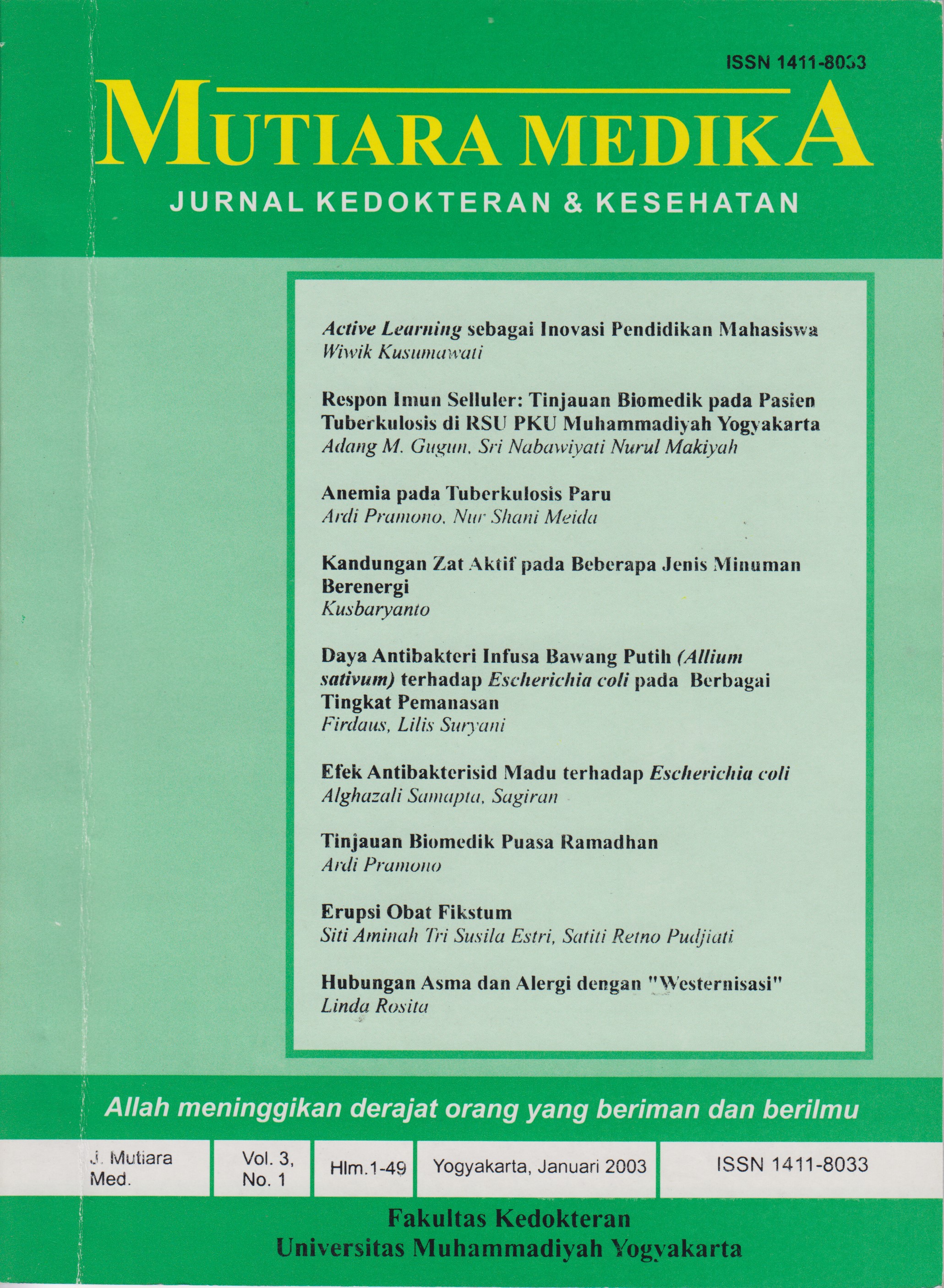Tinjauan Biomedik Puasa Ramadhan
DOI:
https://doi.org/10.18196/mmjkk.v3i1.1546Abstract
Fasting during the month of Ramadan is an obligation for Moslems. They retain from eating and drinking for several hours during the day time from dawn to sunset for about 30 days. However, due to geographic difference Moslems from different part of the world will experience different length of daytime. Those in equatorial regions have more or less little variation, while those in northern or southern hemisphere very much depend on season varia¬tion. Previous studies reveal that fasting during Ramadan may affect biochemi¬cal parameters in human body, however, they seem to remain in normal range. During fasting, the body consumes mainly glucose from gluconeogenesis to produce energy. Glycerol, lactate, and certain amino acids are among others utilised as substrate for gluconeogenesis. This biochemical process produces urea, changes in muscle mass and reduced fat in adiposa tissue. It is sug¬gested that more fat should be consumed while practicing Ramadan fasting.
Puasa di bulan Ramadan merupakan kewajiban bagi muslim yang sudah akil baliq. Puasa dilakukan dengan menahan makan dan minum sejak matahari terbit sampai tenggelam, selama 30 hari di bulan Ramadan. Karena perbedaan muka bumi dan geografis, maka lama puasa setiap hari berbeda di tiap negara. Pada negara di daerah equator sedikit megalami perubahan, sedangkan yang terletak di utara dan selatan garis equator dapat memiliki variasi waktu tergantung musim. Penelitian yang telah dilakukan menunjukkan bahwa puasa Ramadan dapat mempengaruhi parameter biokimiawi tubuh, walaupun masih dalam batas normal Selama puasa, glukosa merupakan sumber energi utama yang berasal dari proses glukoneogenesis. Glukoneogenesis berasal dari gliserol, laktat, dan asam amino glukogenik. Proses glukoneogenesis ini menghasilkan urea, perubahan massa otot, dan penurunan lemak di jaringan adipose. Disarankan agar selama menjalankan puasa Ramadan, meningkatkan konsumsi lemak.
References
A., Ghalim,N., Bcnslimanc, A., Leccrf, J.M., Saile, R. 1997. Fasting During Ramadhan Induces Marked Increase in High-Density Lipoprotein Cholesterol and Decrease in Low- Density Lipoprotein Cholesterol. Ann. Nutr. Metab, 41, 242-9.
AtijJ.E., Beji, C., Danguir,J. 1995. Increased Fat Oxidation During Ramadhan Fasting in Healthy Women: Adaptive Mechanism for Body-Weight Maintenance. Am. J. Clin. Nutr, 62,302-7.
Fedail, S.S., Murphy, D., Salih, S.Y., Bolton, C.H., Harvey, R.F. 1982. Changes in Certain Blood Constituents During Ramadhan. Am. J. Clin. Nutr.. 36, 350-3.
Marks, D.B, Marks, A.D., Smith, C.M. 1996. Fasting. Basic Medical Biochemistry: A Clinical Approach. Williams & Wilkins, Baltimore, Maryland, USA.
Maislos, M., RabiahY.A., Zuili, L, Iordash, S.,Shany, S. 1998. Gorging and Plasma HDL-cholesterol- The Ramadhan Model. European Journal of Clinical Nutrition, 52, 127-130.
Mayes, P.A., 1996. Gluconeogenesis. Harper’s Biochemistry. 24lh ed, Appleton & Lange. Connecti¬cut.
Nagra, S. A., Rahman, Z.U., Javaria, M., Qadri, A.J. 1998. Study of Some Biochemical Parameters in Young Women As Effected by Ramadhan Fasting. Int. J. Ramadhan Fasting Res. 2(1), 1-5.
Nomani, M. Z. A. 1999. Diet During Ramadhan. Int. J. Ramadhan Fasting Res. 3(1-6).
Pramono, A. 2001. Pembandingan Kadar Albumin, Protein Total, Urea, Asam Urat, dan Rasio Urea/ Kreatinin Urin Sebelum dan Sewaktu Puasa Ramadhan. Tesis. Magister Universitas Gadjah Mada.
Downloads
Published
Issue
Section
License
Copyright
Authors retain copyright and grant Mutiara Medika: Jurnal Kedokteran dan Kesehatan (MMJKK) the right of first publication with the work simultaneously licensed under an Attribution 4.0 International (CC BY 4.0) that allows others to remix, adapt and build upon the work with an acknowledgment of the work's authorship and of the initial publication in Mutiara Medika: Jurnal Kedokteran dan Kesehatan (MMJKK).
Authors are permitted to copy and redistribute the journal's published version of the work (e.g., post it to an institutional repository or publish it in a book), with an acknowledgment of its initial publication in Mutiara Medika: Jurnal Kedokteran dan Kesehatan (MMJKK).
License
Articles published in the Mutiara Medika: Jurnal Kedokteran dan Kesehatan (MMJKK) are licensed under an Attribution 4.0 International (CC BY 4.0) license. You are free to:
- Share — copy and redistribute the material in any medium or format.
- Adapt — remix, transform, and build upon the material for any purpose, even commercially.
This license is acceptable for Free Cultural Works. The licensor cannot revoke these freedoms as long as you follow the license terms. Under the following terms:
Attribution — You must give appropriate credit, provide a link to the license, and indicate if changes were made. You may do so in any reasonable manner, but not in any way that suggests the licensor endorses you or your use.
- No additional restrictions — You may not apply legal terms or technological measures that legally restrict others from doing anything the license permits.






